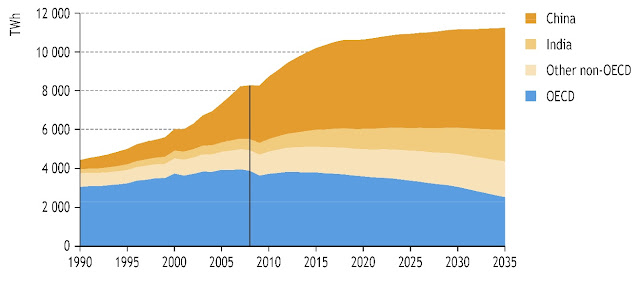The International Energy Agency (IEA) released their 2010
World Energy Outlook this week. The freely available
key graphs file contains two that seem particularly interesting from a macro view. The first shows their forecast for global oil production:
There are a number of things worth noting from this forecast. First, they show that currently producing crude oil fields, taken together, are in terminal decline. There's an implication there that enhanced recovery techniques are not going to save us. Second, total crude production stays almost perfectly level for the next 25 years; by 2035, production from fields we already know about, but are not currently producing, will still be increasing; and fields yet to be found will be producing over 30% of the total conventional crude. I'll say something about how unlikely I find that in a few days. The fact that new production almost exactly offsets the decline in current fields seems suspicious. Finally, total liquids production increases to over 95 million bbl/day, with the increase all coming from natural gas liquids and unconventional sources.
The second graph is the one for the forecast of coal use for generating electricity:
China is forecast to increase their electricity production from coal by almost 50%, driving a global increase of 25% over 2010 levels. You have to think about where the increased production is going to come from. Generation will probably become more efficient, assuming that new plants use supercritical and ultracritical steam cycles, but a substantial increase in coal production will still be necessary. It seems to me that such an increase is at least problematic.
If you are a believer in climate change caused by increasing levels of CO2 in the atmosphere, these two graphs together are extremely discouraging. Unless you believe that China is going to capture and store the emissions from its coal-fired power plants, the graphs tell a story of steadily increasing emission levels, not the rapidly declining levels that would be necessary to stabilize the CO2 levels already present.


No comments:
Post a Comment